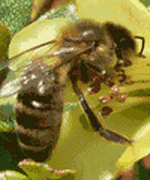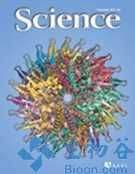PLoS ONE:蜜蜂分泌物2-庚酮可用于局部麻醉
2013-05-06 Beyond 生物谷
我们都知道蜜蜂会咬人。近日,希腊和法国大学生物学家发现蜜蜂除了尾巴会蜇咬外,蜜蜂口腔中分泌的某种物质能够用来局部麻醉。包 蜜蜂蜇咬蜡蛾幼虫等,入侵者会咬猎物分泌2-庚酮到蜡蛾幼虫伤口,导致其瘫痪。作者解释说蜜蜂下颌腺是分泌上述物质的主要部位。 通过形态学研究和解剖,发现2-庚酮的释放不是被动,是在下颌肌肉收缩的基础上积极释放的。2-庚酮是生物学家早已发现一种天然化合物,主要在一些食品包括啤
我们都知道蜜蜂会咬人。近日,希腊和法国大学生物学家发现蜜蜂除了尾巴会蜇咬外,蜜蜂口腔中分泌的某种物质能够用来局部麻醉。包

蜜蜂蜇咬蜡蛾幼虫等,入侵者会咬猎物分泌2-庚酮到蜡蛾幼虫伤口,导致其瘫痪。作者解释说蜜蜂下颌腺是分泌上述物质的主要部位。
通过形态学研究和解剖,发现2-庚酮的释放不是被动,是在下颌肌肉收缩的基础上积极释放的。2-庚酮是生物学家早已发现一种天然化合物,主要在一些食品包括啤酒和白面包,一些昆虫的分泌物正存在。
这一研究发现意味着,蜜蜂分泌的物质2-庚酮有潜力成为人类医学麻醉剂,因为它具有天然、低毒等特性。目前,研究员Vita正将此物质作为局部麻醉剂申请了专利。

doi:10.1371/journal.pone.0047432
PMC:
PMID:
The Bite of the Honeybee: 2-Heptanone Secreted from Honeybee Mandibles during a Bite Acts as a Local Anaesthetic in Insects and Mammals
Alexandros Papachristoforou*, Alexia Kagiava, Chrisovalantis Papaefthimiou,et al.
Honeybees secrete 2-heptanone (2-H) from their mandibular glands when they bite. Researchers have identified several possible functions: 2-H could act as an alarm pheromone to recruit guards and soldiers, it could act as a chemical marker, or it could have some other function. The actual role of 2-H in honeybee behaviour remains unresolved. In this study, we show that 2-H acts as an anaesthetic in small arthropods, such as wax moth larva (WML) and Varroa mites, which are paralysed after a honeybee bite. We demonstrated that honeybee mandibles can penetrate the cuticle of WML, introducing less than one nanolitre of 2-H into the WML open circulatory system and causing instantaneous anaesthetization that lasts for a few minutes. The first indication that 2-H acts as a local anaesthetic was that its effect on larval response, inhibition and recovery is very similar to that of lidocaine. We compared the inhibitory effects of 2-H and lidocaine on voltage-gated sodium channels. Although both compounds blocked the hNav1.6 and hNav1.2 channels, lidocaine was slightly more effective, 2.82 times, on hNav.6. In contrast, when the two compounds were tested using an ex vivo preparation he isolated rat sciatic nerve function of the two compounds was so similar that we were able to definitively classify 2-H as a local anaesthetic. Using the same method, we showed that 2-H has the fastest inhibitory effect of all alkyl-ketones tested, including the isomers 3- and 4-heptanone. This suggests that natural selection may have favoured 2-H over other, similar compounds because of the associated fitness advantages it confers. Our results reveal a previously unknown role of 2-H in honeybee defensive behaviour and due to its minor neurotoxicity show potential for developing a new local anaesthetic from a natural product, which could be used in human and veterinary medicine.
本网站所有内容来源注明为“梅斯医学”或“MedSci原创”的文字、图片和音视频资料,版权均属于梅斯医学所有。非经授权,任何媒体、网站或个人不得转载,授权转载时须注明来源为“梅斯医学”。其它来源的文章系转载文章,或“梅斯号”自媒体发布的文章,仅系出于传递更多信息之目的,本站仅负责审核内容合规,其内容不代表本站立场,本站不负责内容的准确性和版权。如果存在侵权、或不希望被转载的媒体或个人可与我们联系,我们将立即进行删除处理。
在此留言









plus one文章有点质疑
136
#分泌物#
81
#Plos one#
55
小丫小丫小蜜蜂
136
#分泌#
49
#局部#
47
#局部麻醉#
58